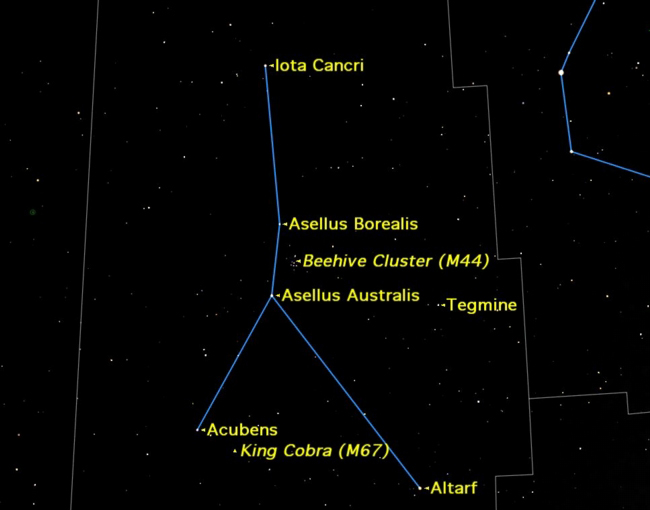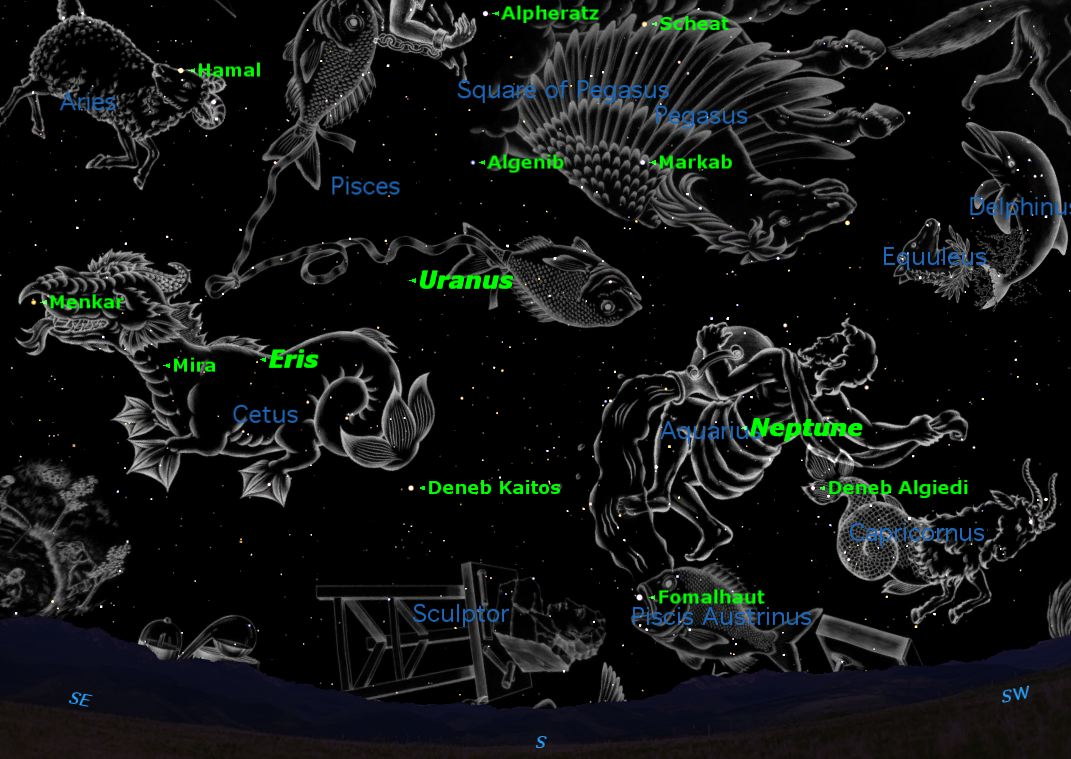
Looking skyward you soon realize that there are spectacular constellations studded with bright stars that seem to get all the attention when they’re above the horizon.
A great case in point is the constellation Orion, which currently stands high toward the south as night falls. During the summer season, our attention turns to Scorpius, the brightest of the 12 zodiacal constellations. And then there’s the lowly crab …
The dim constellation of Cancer, high toward the south during the late evening hours, is the least conspicuous of the 12 zodiacal constellations. The former chief astronomer at New York’s Hayden Planetarium, Ken Franklin (1923-2007) used to refer to Cancer as "the empty space" in the sky. There is not a single star in it that is brighter than fourth magnitude, which means that if you live in a light polluted environment, your chances of sighting it are all but zero. [See images of night sky constellations]
Greek origins
The Greeks felt that these dim stars should represent a creature of insignificance and made reference to the goddess Hera. The goddess was upset that her husband, Zeus, had a fling with a Greek woman named Alcmene. The Greek mortal later gave birth to Hercules, and Hera never looked at Hercules as her son. The goddess decided to pay Zeus back for his infidelity by making the rest of Hercules' life as miserable as she could.
It was during one of her fits of jealousy that Hera sent a crab to attack Hercules at the very moment that he was doing battle with the serpent Hydra. The crab did as he was told and bit Hercules in the foot, but upon backpedaling in his struggle with Hydra, Hercules crushed the crab. Hera rewarded the hapless crustacean by putting him in the sky just above the head of Hydra, but she failed to adorn the crab with any bright stars.
To this day, the unfortunate crab — practically invisible to Hercules — is almost invisible to most stargazers as well.
Get the Space.com Newsletter
Breaking space news, the latest updates on rocket launches, skywatching events and more!
Beehive or manger?
Aside from being in the Zodiac, Cancer is probably only noteworthy because it contains one of the brightest galactic star clusters in the sky. It appears to the eye as a fuzzy patch of light, but binoculars will reveal its stellar nature.
But what to call it? Some astronomy texts speak of "Praesepe, the Manger," while others simply call it the "Beehive." A manger is defined as "a trough in which feed for donkeys is placed." The cluster was apparently first called Praesepe 20 centuries ago. [See video of other night sky events for March 2014]
Two nearby stars, Gamma and Delta Cancri are also known as Asellus Borealis and Asellus Australiis — the northern and southern ass colts — feeding from a manger. Galileo first resolved Praesepe into stars (36 of them) in 1610. More than 100 stars can be seen in binoculars or a small telescope and they seem to be spread out over an area about three times the apparent diameter of the moon.
The cluster’s relatively new moniker, "Beehive," apparently evolved almost four centuries ago, when some anonymous person, upon seeing so many stars revealed in one of the first crude telescopes exclaimed: "It looks just like a swarm of bees!"

Celestial weather forecaster
Praesepe was also used in medieval times as a weather forecaster. It was one of the very few clusters that was mentioned in antiquity.
Aratus (around 260 B.C.) and Hipparchus (about 130 B.C.) called it the "Little Mist" or "Little Cloud." But Aratus also noted that on those occasions when the sky was seemingly clear (but Praesepe was invisible) it meant that a storm was approaching.
Today, we know that prior to the arrival of any unsettled weather, high, thin cirrus clouds (composed of ice crystals) begin to appear in the sky. Such clouds are thin enough to only slightly dim the sun, moon and brighter stars, but apparently just opaque enough to hide a dim patch of light like Praesepe.
A marker for summer
Roughly 3,000 years ago, the point in the sky marking the position of the June solstice lay very close to Praesepe. But thanks to precession — the wobble of Earth’s axis over an interval of 25,800 years — the solstice point has shifted out of Cancer and is now located in the adjacent constellation of Gemini, sliding backward toward the west over the last 3,000 years.
Despite this, on the first day of summer when the sun's direct rays have reached as far north as they can go on the globe we still refer to that geographic parallel as the Tropic of Cancer.
The crab is a creature that can go in one direction as well as another, so it seems only fitting that this part of the sky where the sun has seemingly reversed its direction at the beginning of summer, has been dedicated to this animal.
Joe Rao serves as an instructor and guest lecturer at New York's Hayden Planetarium. He writes about astronomy for Natural History magazine, the Farmer's Almanac and other publications, and he is also an on-camera meteorologist for News 12 Westchester, N.Y. Follow us @Spacedotcom, Facebook and Google+. Original article on Space.com.
Join our Space Forums to keep talking space on the latest missions, night sky and more! And if you have a news tip, correction or comment, let us know at: community@space.com.

Joe Rao is Space.com's skywatching columnist, as well as a veteran meteorologist and eclipse chaser who also serves as an instructor and guest lecturer at New York's Hayden Planetarium. He writes about astronomy for Natural History magazine, Sky & Telescope and other publications. Joe is an 8-time Emmy-nominated meteorologist who served the Putnam Valley region of New York for over 21 years. You can find him on Twitter and YouTube tracking lunar and solar eclipses, meteor showers and more. To find out Joe's latest project, visit him on Twitter.









